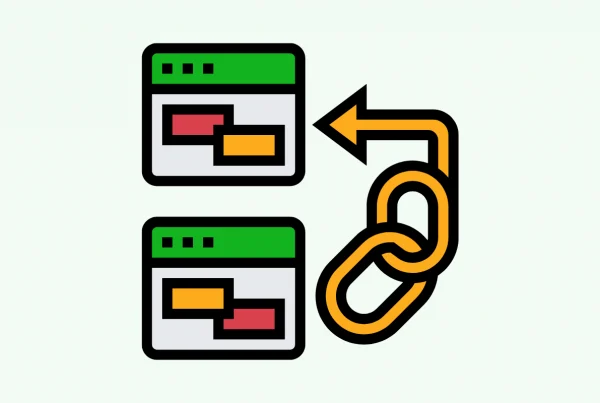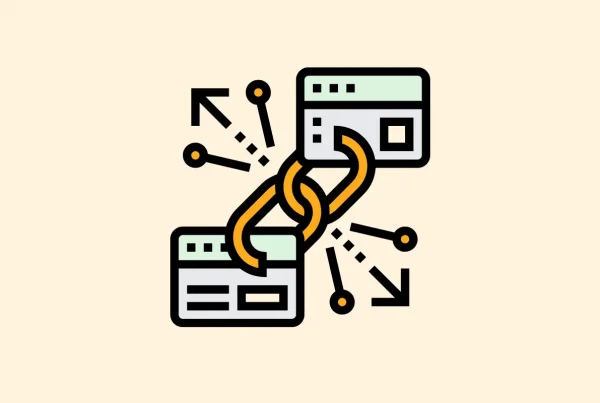Blog article
Internal Linking Automation: The 10-Step SEO Guide
Estimated reading time: 7 minutes
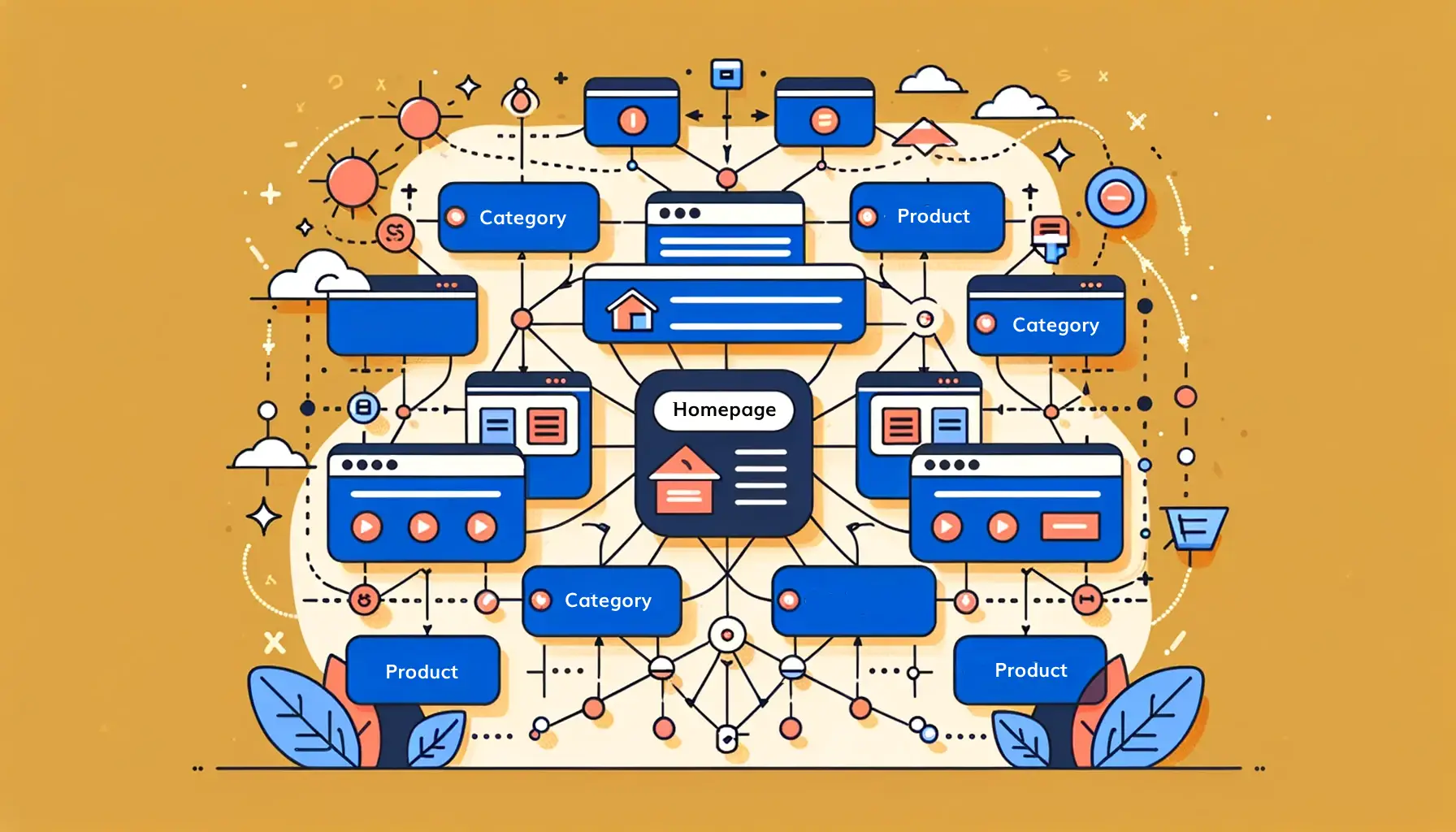
Large websites face unique internal linking challenges, often struggling with the distribution of link equity and the complexity of their site structure. These issues can lead to imbalances where crucial pages lack sufficient internal links, resulting in underperformance in search rankings. Conversely, some pages may have an excess of outgoing links, diluting their link power. This guide aims to address these challenges, offering a comprehensive solution to unlock the SEO potential of large websites.
In this guide, you’ll learn how to effectively manage your internal linking strategy, focusing on automation to handle the scale and complexity of your site. We’ll cover essential steps such as creating a logical and hierarchical site structure, implementing advanced techniques like content clustering, contextual linking, and dynamic internal linking. These strategies are crucial for guiding both search engines and users more effectively through your site.
Moreover, this guide will dive into a case study demonstrating the tangible impact of improved internal linking on organic SERP positions for a leading European classified ad website. We will analyze a set of pages that significantly benefitted from an increased number of internal links, showcasing the direct correlation between well-strategized internal linking and enhanced search engine visibility and rankings.
By following this 10-step guide, you’ll gain insights into optimizing your internal link structures, thereby improving your site’s visibility, user navigation, and overall search engine performance. You’ll discover how to ensure that your priority pages receive the link equity they deserve, how to balance the distribution of internal links, and how to leverage advanced internal link management techniques suitable for the scale of large websites.
What is Internal Linking Automation?
Internal linking automation is a strategic approach tailored for large websites, aimed at streamlining and enhancing their internal link structure. This process is vital for several reasons:
Enhancing page authority and relevance
Internal linking plays a crucial role in determining the authority and relevance of web pages. A well-implemented internal linking strategy can significantly influence a page’s perceived authority, directly impacting its ability to rank in search engine results. With automation, the management of these links becomes more efficient, ensuring that the right pages gain the necessary authority to rank for relevant queries.
Improving site usability and SEO
Effective internal linking also greatly benefits the usability and SEO of a website. Internal links are essential for search engines to discover and understand content. They also help users navigate a website more easily. Automation tools can ensure that these links are placed strategically within content, improving both the user experience and the website’s visibility in search engines.
Streamlining site structure and navigation
For large websites, organizing content in a coherent, hierarchical structure can be a daunting task. Internal linking should be designed to establish a clear hierarchy and thematic relevance, thus guiding users through the website more intuitively. Automated tools can assist in this process, creating a site structure that is not only SEO-friendly but also user-centric, enhancing the overall browsing experience.
Internal linking automation offers a systematic way to enhance page authority, improve SEO performance, and streamline site navigation. By leveraging this approach, websites can overcome the challenges of manual link management and ensure that their content is effectively interconnected, enhancing both their search engine rankings and user engagement.
🔍 For an in-depth exploration of building internal linking specifically for large e-commerce sites, consider this comprehensive guide from Verbolia: How to Build Internal Linking for Large E-Commerce Sites.
Top 5 Benefits of Internal Link-Building
Top 5 Benefits of Internal Link-Building
1. Establishing a clear site hierarchy
A well-structured internal linking strategy helps in organizing content into distinct categories and subcategories. This clear hierarchical arrangement not only aids user navigation but also enables search engines to understand the layout and importance of various pages, improving the website’s SEO performance.
2. Identifying and empowering priority pages
By pinpointing and focusing on priority pages, internal linking ensures that these key pages receive the attention they need. Whether it’s category pages on e-commerce sites or main articles on content platforms, directing more internal links to these pages can significantly boost their rankings in search results as we’ll discuss in our case study later in this article.
3. Enhancing anchor text optimization
Optimized anchor text for internal links is a subtle yet powerful way to improve SEO. By using relevant, concise, and keyword-rich anchor text, you help search engines understand what the linked page is about, which aids in appropriately indexing and ranking that page for related search queries and which ultimately improves their chances of ranking higher.
4. Optimizing link and click depth
Managing the number of clicks required to reach important pages from the homepage (link depth) can drastically improve user experience and site accessibility. A shallow link depth ensures that important content is readily accessible, which is favored by search engine algorithms for crawling and indexing.
5. Leveraging analytical insights for continuous improvement
Internal linking analysis tools like Oncrawl and Botify offer valuable insights into how effectively the internal links are distributed. Regular audits and adjustments based on these insights can lead to continual improvement of the site’s internal linking structure, benefiting both SEO and user experience.
Verbolia’s Linking Engine offers a unique approach to internal linking for large and complex websites. It addresses common challenges such as deep link depth and orphan pages by enabling SEO managers to automatically and contextually add inbound links to priority pages. The tool allows users to select specific anchor texts for each link and carefully selects anchors that match the content of the page, ensuring contextually relevant linking. Additionally, the ease of integration through server-side API or client-side JavaScript makes it a versatile solution. This method has been demonstrated to significantly improve SERP positions, as shown in case studies with large-scale implementations. For more details on how Verbolia’s innovative tool can transform your website’s navigation and SEO, visit their Linking Engine page.
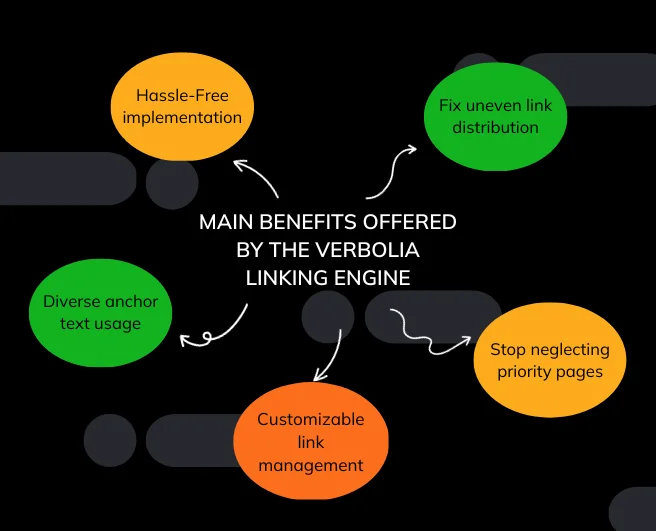
Here are the main benefits offered by the Verbolia Linking Engine
- Fix uneven link distribution: the tool effectively addresses the common problem of uneven link equity distribution in large websites. By automating the process, it ensures a balanced spread of links, enhancing the SEO value of multiple pages.
- Stop neglecting priority pages: Verbolia’s tool focuses on ensuring that priority pages, often neglected in large-scale websites, receive adequate internal links. This boosts their visibility and authority, significantly improving their search engine rankings.
- Diverse anchor text usage: the Linking Engine allows for the selection of specific, contextually relevant links for pages where you wish to add links. This approach not only enhances the relevance of the linked pages but also contributes to a more natural and effective internal linking structure.
- Hassle-Free implementation: one of the key advantages of Verbolia’s Linking Engine is that it doesn’t require internal development resources or planning for code releases. Management of linking configurations is done directly within the Verbolia platform and the integration of links into the website is automated through a JavaScript tag or via the API. This makes it a hassle-free solution for enhancing your website’s internal linking.
- Customizable link management: the tool offers the ability to easily manage linking by configuring rules. This level of customization ensures that the linking strategy aligns perfectly with the specific needs and goals of your website.
For more details, you can visit Verbolia’s Linking Engine page where you can also schedule a demo with one of Verbolia’s experts.
How To Automate Internal Links
- Identify poorly linked pages: the first step in automating internal links is to identify pages on your site that are poorly linked. This includes orphan pages or those with shallow depth. Use internal linking analysis tools to find these pages. When assessing pages, consider those as poorly ranked if they are deep within the site structure and have low PageRank. Pages deeper in the site structure, beyond a certain level, typically rank poorly because they are linked to less often and have less internal PageRank. Google tends to prioritize crawling URLs with a lower page depth. Therefore, identifying pages that are buried deep (e.g., beyond a depth of 5) can be a good starting point.
- Prioritize pages for improvement: once you’ve identified poorly linked pages, determine which ones are a priority. These could be pages that are not ranking well but target keywords with search volume and have relevant content or product offers. It can be useful to assign a ranking from 0 to 10 to each page, with pages ranked as 10 receiving the most popularity or inlinks within the website. This can help in identifying which pages need more internal links to improve their perceived importance and rankings.
- Assign anchors for identified priority pages: before creating rules for link placement, it’s important to assign appropriate anchor texts to the identified priority pages. Anchor texts should be descriptive and keyword-rich, providing context to both users and search engines. A good practice is to use a mix of phrase match anchors (about 60%), exact match anchors (around 30%), and partial match keywords or variations (about 10%). Avoid using generic anchor texts like “click here” or “read more”, as they don’t provide much context. It’s also crucial to ensure that the same anchor text is not used for different URLs on the same website, to avoid confusion for search engine crawlers.
- Create rules for link placement: after identifying pages that need improvement and selecting anchors, decide where on your website you want to link to these priority pages. This could be, for instance, all category pages. In this step, you should also define which HTML element of the page best describes what the page is about. This is often the Page Title or an H1 tag.
- Fine-tune Link Trigger Conditions: in this step, you should specify how Verbolia should select anchors and links to ensure contextually relevant linking. For instance, if H1 tags are the most descriptive elements of your pages, you can configure Verbolia to select the most suitable anchors and links based on the content of these H1 tags. This approach ensures that the links added to your site are contextually relevant and aligned with the specific content of each page. Additionally, Verbolia allows you to set multiple rules, enabling manual selection of links on certain pages or configuring exceptions where necessary. This level of customization ensures that your internal linking strategy is finely tuned to your site’s unique content and structure, enhancing both SEO performance and user experience.
- Design and Preview Link Placement: before fully implementing the new links, decide where links should be added in your page and visualize how they will appear on your site. This is important to ensure that the links fit naturally into your content and site layout.
- Implement and Monitor: finally, apply the changes and continuously monitor their impact. Use tools like Oncrawl and Botify to track improvements in page ranking and depth, and adjust your strategy as needed.
By following these steps, you can efficiently automate the internal linking process on your website, addressing issues of page depth and improving the overall SEO performance of your key pages.
Challenges of Automating Internal Linking
Be cautious: while automating internal linking for large websites can improve rankings of previously less-visible or inadequately linked pages, it also introduces a range of challenges that necessitate careful and strategic solutions. Below is a detailed overview of common issues you might encounter, accompanied by practical solutions for each:
Challenge 1: Orphaned Pages
Orphaned pages are those without any internal links pointing to them, making them isolated and potentially unindexed by search engines.
Solution: regular audits using SEO tools can identify these pages. Implementing systems that automatically link to new and existing content can prevent pages from becoming orphaned.
Challenge 2: Excessive Links on a Single Page
Having too many links on a page can dilute the value of each link and overwhelm users.
Solution: use tools like Google Analytics to identify and remove unclicked links. Maintain a balance in the number of internal links, aiming for a moderate amount that enhances user experience and SEO value. A general rule of thumb for large websites is to keep the number of internal links on a single page below a few hundred.
Challenge 3: Improper Use of Redirects
Redirect chains and loops, especially with temporary redirects, can slow down your website and confuse search bots.
Solution: minimize the use of redirects, and if necessary, ensure they are direct to the final page. Regularly review all URLs with redirects and update them to target page URLs where possible.
Challenge 4: Ineffective Anchor Text Usage
Using non-descriptive or irrelevant anchor texts can negatively impact user experience and SEO.
Solution: ensure anchors are descriptive and relevant to the linked content. They should align with the target page’s content and contribute to its keyword relevance.
Challenge 5: Inadequate Site Structure and Navigation
A poorly structured website can result in navigational challenges and inefficient internal linking.
Solution: structure your website logically, ensuring clear and intuitive navigation. Use breadcrumb navigation and categorize content appropriately to enhance both user experience and internal linking effectiveness.
Challenge 6: Misuse of Nofollow Attributes
Incorrect use of nofollow attributes on internal links can lead to loss of PageRank and missed opportunities in guiding search bots.
Solution: review nofollow links on your site and remove the tag where unnecessary, especially for internal links, to allow proper flow of internal linking juice.
Challenge 7: Deep Crawl Depth
Having important pages buried deep in the site structure (more than 5 clicks from the homepage) can negatively affect SEO.
Solution: rearrange your internal link architecture to ensure that important content is reachable within 3 to 5 clicks from the homepage.
Challenge 8: Pages with Insufficient Internal Links
Pages with only one or very few incoming internal links might be underutilized in terms of SEO and visibility.
Solution: increase the number of relevant internal links pointing to these underlinked pages, enhancing their visibility and importance to search engines.
Challenge 9: Masked or Cloaked URLs
Masked links can appear deceptive to users and are not recommended for SEO.
Solution: be transparent with your URLs and ensure they accurately represent the destination page.
Challenge 10: Poor Balance of Internal and External Links
An imbalance between internal and external links can affect the overall effectiveness of your link strategy.
Solution: maintain a healthy balance of internal and external links. Both types are valuable for providing a comprehensive resource to your readers and for SEO. A general rule of thumb is to have a mix that naturally complements the content. While there’s no fixed ratio, a practical approach is to ensure that external links are used judiciously, mainly when they add significant value or authority to the content. Internal links should be the majority, focusing on improving user navigation and SEO within your site. The key is to prioritize the user experience and content relevance over a strict numerical formula, adjusting as needed based on the specific context of each page.
In summary, while automating internal linking poses these challenges, they can be addressed through regular audits, proper use of SEO tools, and thoughtful implementation of linking strategies. The key is to balance automation with strategic oversight to maintain an effective, user-friendly, and SEO-friendly internal linking structure.
Automated Internal Links Case study
Automated Internal linking for a European Classified ad Giant
This case study highlights the profound impact of automated internal linking on large-scale websites
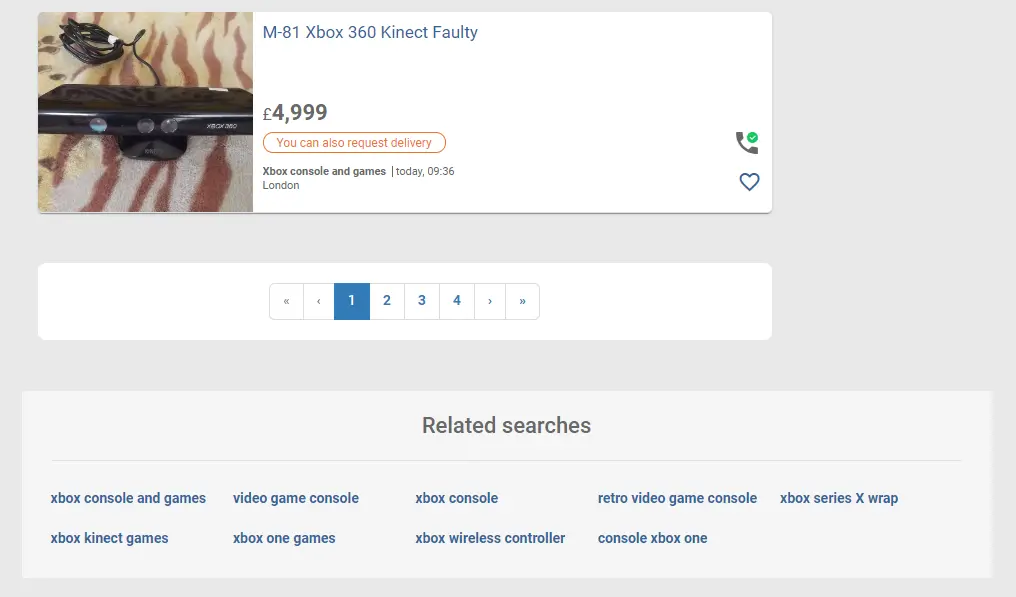
Background the client, a major player in the European classified ads market, had a vast online presence with millions of pages. A significant portion of these pages suffered from poor internal linking, resulting in suboptimal search engine visibility and user engagement.
Approach our internal link automation strategy was multi-faceted, encompassing several key steps:
- Identification of Poorly Linked Pages: we used internal linking tools to find pages with minimal internal links. From these, we identified priority pages based on the selection criteria like Monthly Search Volume (indicating potential search visibility), the number of relevant ads per page (showing conversion potential), and existing SERP rankings.
- Anchor Text Optimization: selected pages were equipped with descriptive anchor texts, enhancing their relevance and search engine understanding.
- Design and Implementation of Linking Blocks: we designed a linking block, which were then integrated across all indexable product listing pages. This included category pages, indexed filter pages, and search result pages. We chose to integrate the linking block below pagination.
- HTML Element Definition: we selected specific HTML elements that best describe the content and purpose of each page. These elements were then utilized to feed the Verbolia linking engine.
- Relevancy as a Key Criterion: focus was on ensuring relevancy between the page content and the injected links, maximizing contextual appropriateness.
Results The outcome of this initiative was analyzed by comparing Google SERP positions of all 100,000 pages, before and six months after the implementation:
- Positive Movement: 29,309 pages showed improved rankings.
- Negative Movement: 8,548 pages experienced a drop in rankings.
- Stability: 63,010 pages maintained their positions.
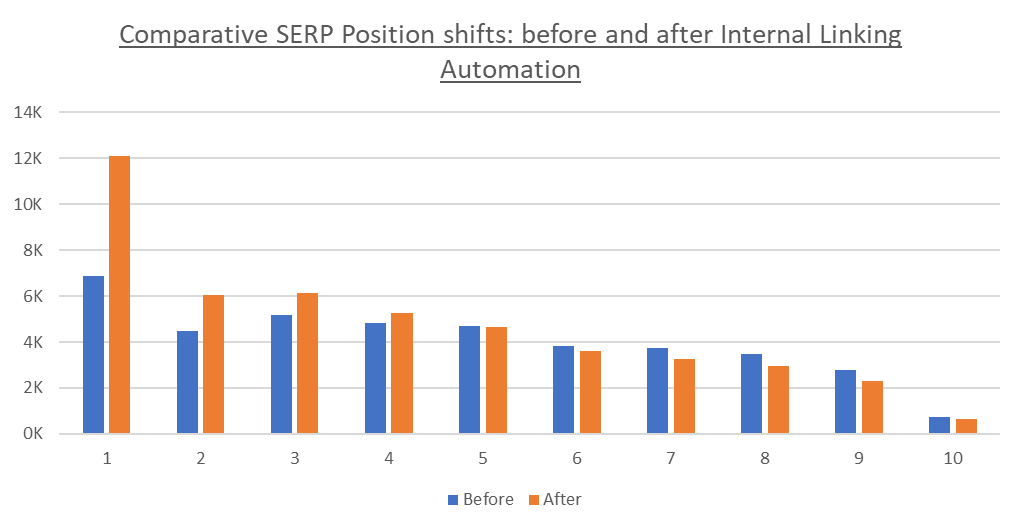
Significant Findings:
- The number of pages ranking first almost doubled post-implementation (from 6,891 to 12,118).
- Across all ranking positions, there was a noticeable shift towards a higher percentage of pages ranking in the Top 3.
Conclusion this case study vividly illustrates the effectiveness of a well-planned and executed internal linking strategy, especially for large websites. By focusing on the right pages and optimizing linking strategies, the client not only improved their SERP positions but also enhanced the overall user experience on their platform. This approach serves as a testament to the power of internal linking in SEO and the benefits of automation in managing vast web structures.
Ready to automate your internal linking and boost your SEO?
Ready to elevate your website’s SEO with automated internal link building? Discover the power of Verbolia’s Linking Engine, a tool designed to optimize your internal linking effortlessly. Experience firsthand how strategic automation can transform your site’s search engine performance and user engagement. Don’t miss this opportunity to revolutionize your website’s internal linking structure. Book a demo now and take the first step towards SEO excellence: Experience Verbolia’s Linking Engine.
About The Author
How can Verbolia help your e-commerce platform.
